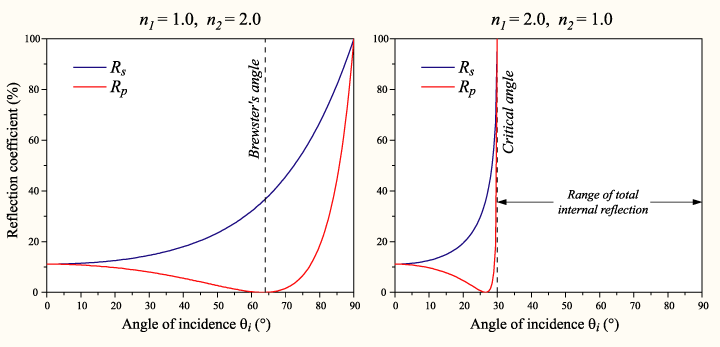Fresnel equations
|
|
The Fresnel equations, deduced by Augustin-Jean Fresnel, describe the behaviour of light when moving between media of differing refractive indices.
When light moves from a medium of a given refractive index n1 into a second medium with refractive index n2, both reflection and refraction of the light may occur.
In the diagram on the right, an incident light ray PO strikes at point O the interface between two media of refractive indexes n1 and n2. Part of the ray is reflected as ray OQ and part refracted as ray OS. The angles that the incident, reflected and refracted rays make to the normal of the interface are given as θi, θr and θt, respectively. The relationship between these angles is given by the law of reflection and Snell's law. (*It should be noted that the discussion given here is only valid for μ=μ0 in both mediums, this happens to be true for most materials but the completely general fresnel's equations are a bit uglier)
The fraction of the incident light that is reflected from the interface is given by the reflection coefficient R, and the fraction refracted by the transmission coefficient T. The Fresnel equations may be used to calculate R and T in a given situation.
The calculations of R and T depend on polarisation of the incident ray. If the light is polarised with the electric field of the light perpendicular to the plane of the diagram above (s-polarised), the reflection coefficient is given by:
- <math>R_s = \left( \frac{\sin (\theta_i - \theta_t)}{\sin (\theta_i + \theta_t)} \right)^2=\left(\frac{n_1\cos(\theta_i)-n_2\cos(\theta_t)}{n_1\cos(\theta_i)+n_2\cos(\theta_t)}\right)^2<math>
where θt can be derived from θi by Snell's law.
If the incident light is polarised in the plane of the diagram (p-polarised), the R is given by:
- <math>R_p = \left( \frac{\tan (\theta_i - \theta_t)}{\tan (\theta_i + \theta_t)} \right)^2=\left(\frac{n_2\cos(\theta_i)-n_1\cos(\theta_t)}{n_2\cos(\theta_i)+n_1\cos(\theta_t)}\right)^2<math>
The transmission coefficient in each case is given by Ts = 1 − Rs and Tp = 1 − Rp.
If the incident light is unpolarised (containing an equal mix of s- and p-polarisations), the reflection coefficient is R = (Rs + Rp)/2.
At one particular angle for a given n1 and n2, the value of Rp goes to zero and an p-polarised incident ray is purely refracted. This is known as Brewster's angle, and is around 56° for a glass medium in air or vacuum.
When moving from a more dense medium into a less dense one (i.e. n1 > n2), above an incidence angle known as the critical angle, all light is reflected and Rs = Rp = 1. This phenomenon is known as total internal reflection. The critical angle is approximately 41° for glass in air.
When the light is at near-normal incidence to the interface (θi ≈ θt ≈ 0), the reflection and transmission coefficient are given by:
- <math>R = R_s = R_p = \left( \frac{n_1 - n_2}{n_1 + n_2} \right)^2<math>
- <math>T = T_s = T_p = 1-R = \frac{4 n_1 n_2}{\left(n_1 + n_2 \right)^2} <math>
Note that reflection by a window is from the front side as well as the back side, and that the latter also includes light that goes back and forth a number of times between the two sides. The combined reflection coefficient is 2R/(1 + R).
Repeated reflection and refraction on thin, parallel layers is also known as Fabry-Perot interference, this effect is responsible for the colours seen in oil films on water, used in optics to make reflection free lenses and perfect mirrors, etc.de:Fresnelsche Formeln


